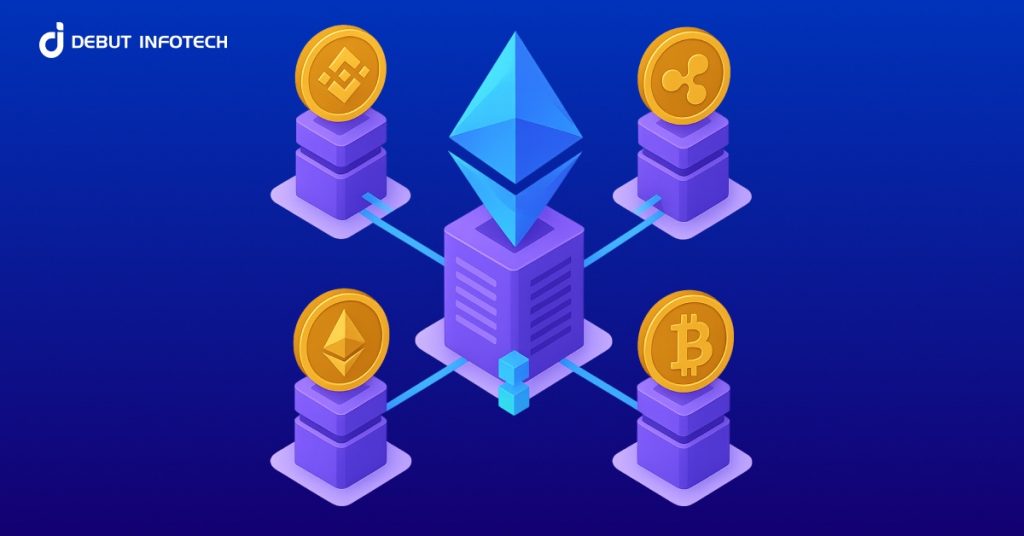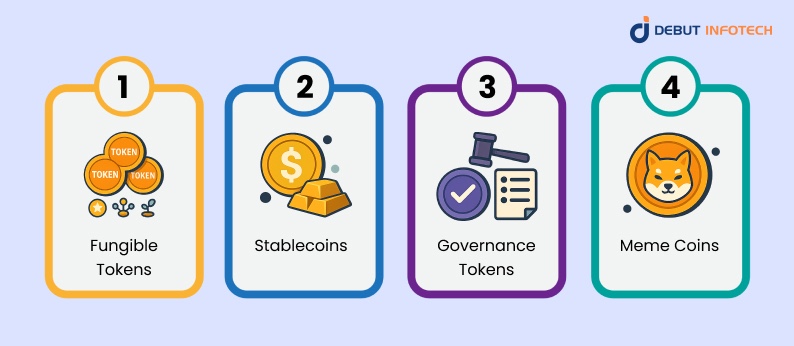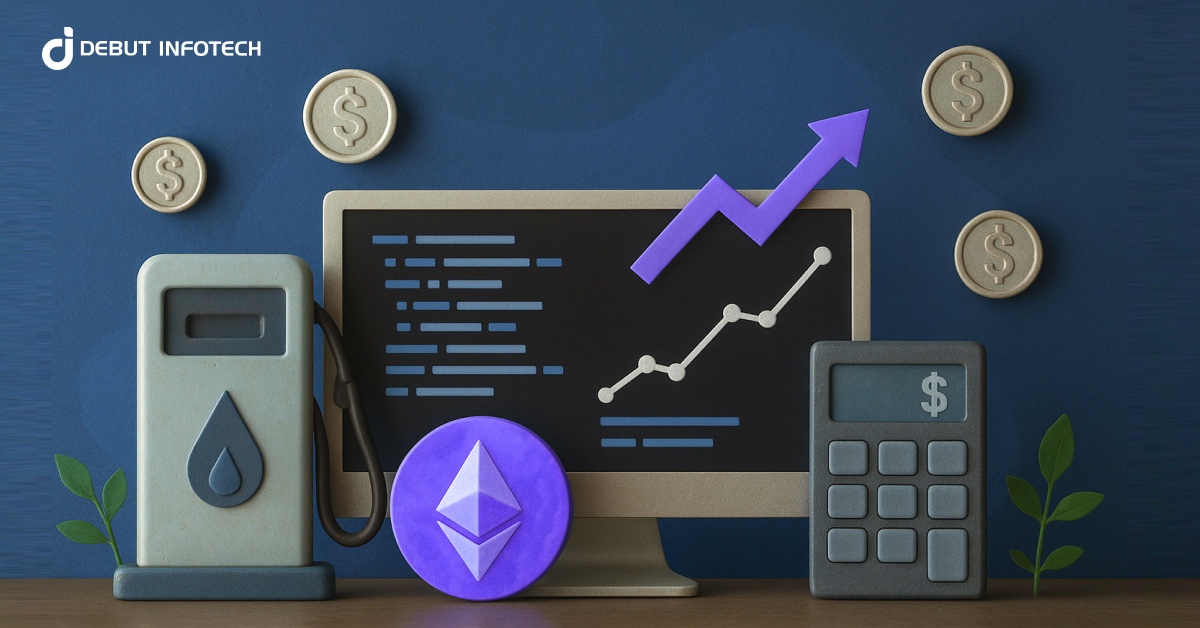
|
Getting your Trinity Audio player ready...
|
Crypto token development has opened up opportunities for startups, enterprises, and even hobbyists to create digital assets for utility, fundraising, governance, or community-building. When supported by robust front-end and back-end infrastructures, tokens can be issued and managed through platforms offered by a crypto token development company, powering features such as payment launchpad gateway integration, meme coin development, and stablecoin development services.
But how do you actually build one? If you’re wondering how to develop a crypto token, or you’re thinking of how to hire a crypto token developer, this guide walks you through every step—from tokenomics design and smart contract creation to launch strategies like ICO development, IEO Development, STO Development, or IDO development company models.
Supercharge Your Next Web Project
Looking to build scalable, high-performance web apps using the latest frameworks? Let Debut Infotech’s dedicated software development team turn your ideas into robust digital solutions.
What Is a Crypto Token?
Crypto tokens are programmable digital assets that exist within blockchain ecosystems. Unlike cryptocurrencies such as Bitcoin or Ethereum, which operate on their own standalone blockchains, tokens are built on top of existing blockchains—most commonly Ethereum, Binance Smart Chain (BSC), Solana, or Polygon. These tokens can serve multiple functions, ranging from representing value and assets to granting access and powering applications.
Tokens are created using smart contracts—self-executing pieces of code that define how tokens behave. Their versatility makes them an integral part of decentralized applications (dApps), digital economies, fundraising efforts, and even governance systems. When issued through a reputable crypto token development company, tokens can become valuable components of secure and scalable blockchain ecosystems.
Crypto Tokens vs Coins: Understanding the Difference
To the untrained eye, “coins” and “tokens” may seem interchangeable, but there’s a key technical distinction:
- Coins are native to their own blockchains. For example, Bitcoin runs on the Bitcoin blockchain, and Ether is the native coin of the Ethereum blockchain. These coins are primarily used as currency or for staking, paying fees, or transferring value.
- Tokens, on the other hand, are created on top of existing blockchains. They rely on a blockchain’s infrastructure to function. For instance, a new ERC20 token uses Ethereum’s security, consensus mechanism, and network nodes, but it operates independently with its own rules.
Types of Crypto Tokens
Tokens can be customized to serve various roles in the ecosystem. Here are some of the most common types of tokens used today:

Fungible Tokens
Fungible tokens are interchangeable and divisible. Each token holds the same value as another of its kind, making them ideal for currency-like use cases. Standards such as ERC20 token development (on Ethereum) and BEP20 token (on Binance Smart Chain) are widely used to create these tokens.
These are ideal for:
- Reward points
- In-game currencies
- Staking and yield farming
- Exchange-tradable assets
Fungible tokens form the basis of many utility and governance tokens and popular meme coins.
Stablecoins
Stablecoins are designed to reduce volatility by pegging their value to traditional assets like fiat currencies (e.g., USD) or commodities (e.g., gold). A Stablecoin Development company often develops them and is backed by reserves held in banks or algorithmic mechanisms.
Common use cases include:
- Remittances and cross-border payments
- Hedging against crypto volatility
- On-ramp and off-ramp for fiat currency in decentralized finance (DeFi)
Popular examples include USDT (Tether), USDC, and DAI—all of which use smart contract logic to maintain price stability.
Governance Tokens
Governance tokens empower holders to influence protocol decisions in decentralized applications (dApps) and decentralized autonomous organizations (DAOs). These tokens are essential for projects seeking to remain decentralized and community-driven.
With governance tokens, users can:
- Propose and vote on protocol upgrades
- Allocate treasury funds
- Influence product direction
DAOs like Uniswap and Aave use governance tokens to maintain transparent and democratic ecosystems.
Meme Coins
Meme coin development has gained significant popularity due to its viral and community-driven nature. Although meme coins are often created as jokes or satire, many have evolved into valuable digital assets with large followings and real-world uses.
Famous examples include Dogecoin and Shiba Inu. While they may not always serve a clear utility, meme coins demonstrate how online communities can drive token adoption at scale.
Meme coins are typically developed quickly using platforms like Binance Smart Chain or Ethereum and require minimal infrastructure. Their success often hinges on timing, branding, and influencer marketing.
Why Crypto Tokens Matter
Crypto tokens democratize asset creation and ownership. They allow anyone—from startups to enterprises—to build digital economies, engage users, raise funds, or decentralize control. Whether it’s a utility token powering an app, a stablecoin facilitating payments, or a governance token enabling community voting, tokens are central to the next evolution of the internet: Web3.
With the right crypto token development services, projects can design tokens that are secure, scalable, and tailored to their unique vision—whether they’re launching a new dApp, building a decentralized exchange, or crafting the next big meme token.
Why Launch a Token?
Developers and businesses launch tokens for various reasons:
- To raise capital via ICO development, where tokens are sold directly to participants.
- Through IEO Development via exchanges that manage investor onboarding.
- Using IDO development company models, which leverage decentralized exchange ecosystems for fast, community-backed launches.
- Issuing compliant tokens via STO Development, aimed at institutional or regulated investors.
Here’s a fully expanded, detailed, and properly formatted version of the “Planning Your Token” section for your article on crypto token development. This version aligns with professional blog structure and maintains clarity for a technical and semi-technical audience.
Planning Your Token
Crypto token success starts with strategic planning—defining purpose, structure, and compliance. This foundation guides blockchain choice, token standards like ERC20 or BEP20, and launch methods such as ICO, IEO, or STO through in-house teams or a crypto token development company.
Define the Purpose and Tokenomics
Every token needs a clearly defined use case. Why are you creating this token? What problem does it solve, or what ecosystem does it fuel?
Common purposes include:
- Utility Tokens: These are used to access features, pay for services, or participate in activities on a platform. A typical example is a decentralized file storage platform that requires users to pay using its native utility token.
- Governance Tokens: These tokens enable users to vote on changes or decisions within a protocol or DAO. They are key in community-led DeFi ecosystems, where holders vote on protocol upgrades or treasury allocations.
- Stablecoins: Designed for price stability, these tokens are pegged to fiat currencies or commodities. Stablecoin development services ensure regulatory compliance and algorithmic or collateral-based price management.
- Meme Coins / Social Tokens: Created to build communities, reward engagement, or go viral through cultural relevance. Meme coin development thrives on hype, branding, and strong community backing.
Next, define your tokenomics. Key parameters include:
- Total Supply – How many tokens will exist in total?
- Initial Distribution – What portion goes to the team, early investors, public sale, and the community?
- Vesting Schedules – How will tokens be unlocked over time to prevent early dumps?
- Burn Mechanisms – Will tokens be periodically destroyed to manage inflation and scarcity?
Strong tokenomics are essential for both investor confidence and long-term market performance.
Choose the Right Blockchain and Token Standards
Your token’s home chain will determine its transaction cost, community reach, ecosystem compatibility, and overall usability.
Popular token standards include:
- ERC20 (Ethereum): The most widely adopted token standard. It offers deep liquidity, developer support, and interoperability with DeFi protocols. However, high gas fees can be a concern for users.
- BEP20 (Binance Smart Chain): A cheaper and faster alternative to Ethereum. It’s ideal for low-cost launches and allows easy listing on decentralized exchanges within the BSC ecosystem.
- Other Blockchains: Depending on your project needs, you might explore:
- Polygon: Offers scalability and Ethereum.
- Solana: Known for speed and low fees
- Avalanche: Suitable for DeFi and enterprise applications
- Tron/XDC: Fast-growing ecosystems with smart contract functionality
- Polygon: Offers scalability and Ethereum.
Your choice will depend on your priorities—whether that’s scalability, cost-efficiency, or compatibility with existing dApps.
Building the Token: Smart Contracts and Security
Once your planning is finalized, the development phase begins. This stage involves writing and deploying the smart contract code that governs the behavior of your token.
Smart Contract Development
Smart contracts are at the heart of any token. These self-executing programs define how tokens are transferred, minted, burned, or paused.
Additional smart contract features may include:
- Minting: Allowing new tokens to be generated under certain rules
- Burning: Permitting permanent removal of tokens to reduce supply
- Pausing: Temporarily freezing token activity for emergencies
- Role Management: Setting specific permissions for admins, minters, or burners
Your chosen crypto token developer should follow best practices in smart contract architecture, code commenting, and modularity.
Ensuring Security
Smart contract vulnerabilities can result in millions in losses, so security must be built into every stage of token development.
Best practices include:
- Using Trusted Libraries: Frameworks like OpenZeppelin offer pre-audited, community-tested contract templates.
- Testing Rigorously: Use unit testing and integration testing to simulate edge cases, token transfers, and exploit scenarios.
- Formal Audits: Hire third-party blockchain security firms to audit your contracts before going live.
Consider on-chain monitoring, bug bounty programs, and community alert systems for real-time response for production launches.
Deployment: From Testnet to Mainnet
Token deployment is a multi-stage process, often starting on a testnet like Ropsten (for Ethereum) or BSC Testnet. This stage allows your team to test contracts in a live simulation environment without risking real assets.
Once the test phase is complete and contracts are audited, you’ll deploy to the mainnet. Key considerations include:
- Gas Fees: The Cost of deploying and initializing contracts varies across chains.
- Contract Verification: Publishing your source code improves transparency.
- Owner Functions: Decide if you’ll renounce ownership or retain upgrade permissions.
Once deployed, your token becomes publicly accessible and usable in wallets, dApps, and exchanges.
Integrating Sale Mechanisms
After deployment, most projects integrate sales mechanisms to distribute tokens and raise capital.
ICO Development (Initial Coin Offering)
An ICO is a self-hosted sale managed directly on your website or app. It gives you full control over the process.
Key features include:
- User-friendly token purchase interfaces
- Wallet integration and transaction confirmation
- Refund or cap management
- KYC/AML compliance integration
This route requires greater infrastructure but also maximizes flexibility and brand control.
Related Read: How AML Affects Crypto Platforms
IEO & IDO Launch Strategies
Launching through an IEO (Initial Exchange Offering) or IDO (Initial DEX Offering) leverages third-party platforms to simplify launch and access existing user bases.
Benefits include:
- Built-in liquidity via DEX pools
- Exchange-handled onboarding and KYC
- Fast token listing and price discovery
Work with an IDO development company or exchange partner to plan schedules, marketing, and token economics.
STO Development (Security Token Offering)
If your token represents a real-world asset (like company equity or revenue), you’ll need a regulated offering. STOs comply with security laws and are used for regulated investor offerings.
Requirements include:
- Legal registration and filings
- Accredited investor screening
- Use of escrow accounts
- Ongoing financial disclosures
STOs are ideal for enterprises, real estate tokenization, and equity-backed DeFi platforms.
Related Read: ICO vs STO vs IEO Compared
Launch and Ecosystem Growth
After sale completion, it’s time to support your token’s usage and community.
Exchange Listings and Liquidity
Listing on exchanges ensures users can buy and sell your token.
- Centralized Exchanges (CEX): Offer credibility and broader exposure
- Decentralized Exchanges (DEX): Enable permissionless, trustless trading
- Payment Launchpad Gateway: Some tokens enable instant swaps, purchases, and fiat onramps
You must also establish liquidity pools, market-making bots, and price-stabilizing mechanisms.
Utility and Adoption
The true test of your token lies in its usefulness. A token with utility fosters demand and retention.
Strategies to drive adoption:
- Token-gated features (e.g., content access, special perks)
- Community staking and reward mechanisms
- Integration into wallets, games, platforms, or dApps
- Real-world utility in DeFi, gaming, or social platforms
Work with token development companies that understand how to align tokenomics with long-term product goals.
Governance, Maintenance, and Security
Your work doesn’t end at launch. Continued governance, maintenance, and compliance are critical to long-term success.
Governance & Upgrades
Tokens that enable user governance should integrate DAO structures. This allows:
- Community proposal submissions
- On-chain voting mechanisms
- Treasury management
If governance is not decentralized from the start, plan for staged decentralization as the project matures.
Compliance and Security Best Practices
Every token must be built with evolving regulations in mind.
- Taxation: Classify your token correctly for tax reporting
- AML/KYC: Required for regulated offerings or fiat integrations
- On-Chain Security: Use multisig wallets, timelocks, and smart contract monitoring
- Bug Bounties: Incentivize white-hat hackers to identify vulnerabilities
Staying ahead of regulatory requirements ensures business continuity and protects investor trust.
Related Read: Why KYC Matters in Exchanges
Cost & Timeline Breakdown
| Token Type | Cost Range (USD) |
| Simple ERC20 token | $2,000–$5,000 |
| Asset-backed or stablecoin launch | $10,000–$50,000+ |
| Full platform with sale interface | $20,000–$100,000+ |
Project Timeline
- Basic token creation: 2–4 weeks
- Sale interface and integrations: +4–8 weeks
- Full ecosystem development: 3–6 months
Build with the Best Frameworks in 2025
Whether you’re launching a startup or upgrading enterprise software, our experts help you choose the best framework for web development tailored to your goals.
Conclusion
Crypto token development is a powerful, versatile field. Whether you’re planning a simple utility token, a fun meme coin, or a compliant STO, proper design and execution are essential. Building through a trusted crypto token development company, working with a seasoned crypto token developer, and integrating security and legal rigor will ensure your token launch is smooth, scalable, and sustainable. Look for firms with expertise in technical implementation and regulatory compliance, especially with specializations in crypto token development services. If you’re ready to move from concept to launch—or still learning how to develop a crypto token—Debut Infotech can guide you each step of the way.
Frequently Asked Questions
A. A web development framework is a collection of pre-written code, libraries, and tools that streamline building websites or web applications. It helps developers focus more on application logic instead of repetitive coding tasks.
A. Choosing the best framework depends on your project’s goals, team expertise, scalability needs, and the desired tech stack. With modern development tools, you should also consider performance, community support, and integration capabilities.
A. Front-end frameworks (like React or Vue) manage what users see and interact with. Back-end frameworks (like Laravel or Django) handle server-side operations such as database access, API handling, and server logic.
A. Yes, PHP frameworks like Laravel and Yii2 remain relevant, especially for businesses that rely on established PHP infrastructure. A good PHP development company can leverage these tools for powerful and scalable web apps.
A. The cost varies based on project complexity, features, framework choice, and whether you’re hiring a dedicated software development team. Basic apps may cost a few thousand dollars, while enterprise systems can go into six figures.
A. Progressive web development involves creating web apps that function like native apps on mobile. Frameworks like Angular, React with Next.js, and Vue with Nuxt.js support this approach through service workers, offline support, and push notifications.
A. Yes, many companies now hire dedicated remote developers to build custom web applications. This approach offers flexibility, access to global talent, and cost efficiency, especially when using a trusted web development services provider.


